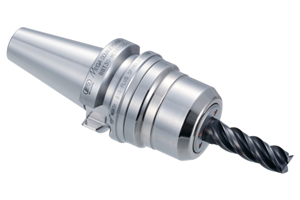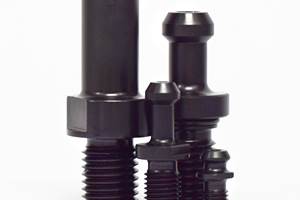Spindle System Has Dual Contact V-Taper
Most CNC machining centers use one of two spindle systems. The most common system is the solid V-taper. Gaining in popularity is the hollow shank or HSK-type spindle system.
Share





.png;maxWidth=45)
DMG MORI - Cincinnati
Featured Content
View More
Takumi USA
Featured Content
View More



Autodesk, Inc.
Featured Content
View MoreMost CNC machining centers use one of two spindle systems. The most common system is the solid V-taper. Gaining in popularity is the hollow shank or HSK-type spindle system.
The two systems are not interchangeable. A V-taper type tool will not fit a HSK spindle and vice versa.
The most significant functional difference between these two spindle systems is that HSK provides dual contact between the spindle face and taper while a conventional V-taper only makes taper contact. A new spindle system from Daishowa Seiki Company, Ltd. (Awaji, Japan) is designed to provide the dual contact advantages of an HSK system for solid body, V-taper tooling.
Although the new system, called Big Plus, requires a special toolholder and spindle, it is fundamentally V-taper style. As such it is interchangeable with conventional V-taper tooling. A No. 50 taper Big Plus spindle will accept either a dual contact tool holder or a standard No. 50 V-flange tool holder. Shops with machining centers equipped with these new spindle systems can continue to use their existing store of conventional V-taper tooling—which usually represents a significant investment.
A standard V-taper tool system is designed to make contact along a fixed taper in the machining center spindle. The tool is held firm against this taper by a drawbar mechanism. When a conventional holder is seated in the spindle, there is a 3 mm gap between the tool holder flange and the spindle face.
As machining spindle speeds increase, shops are finding that V-taper tooling systems may lose some dimensional accuracy due to centrifugal forces imposed by high rotational spindle speeds. The mouth of the machining center spindle can grow slightly (it's called bell mouthing) at high rpm and as it grows the V-taper tool, which is under constant drawbar pull, moves up the expanded taper.
On high tolerance applications, this slight pull back of the cutter can affect dimensional accuracy of the Z-axis. Pull back can also cause the toolholder to stick in the spindle.
Dual contact, involving the toolholder shank (taper) and the toolholder flange, is a method to eliminate pull-back of the toolholder. Precision machining for the spindle bore, toolholder taper and flange creates a connection that allows the taper and face to seat at the same time thus creating dual or simultaneous contact on the two surfaces.
The V-taper contacts the spindle taper and flange contact on the spindle face make a solid union in both the axial and radial planes. In operation, dual contact tool holders are resistant to axial movement because the face contact prevents the toolholder from being pulled up into the spindle at high speed.
An additional machining benefit is improved cutter rigidity from the extra contact area created by spindle face contact added to the taper contact. With dual contact systems, the cutting tool generally takes higher radial forces because the flange contact plus the taper contact combine to resist deflection.
To achieve dual contact for the tool shank taper and the flange, 1.5 mm is added to the spindle face and 1.5 mm is added to the toolholder flange. The taper is not changed.
Adding this material effectively closes the 3 mm gap between the spindle face and the toolholder flange. Eliminating the gap allows these tools to have dual contact.
The ability to interchange these toolholders comes from standardizing the V-taper fit between the tool shank and the spindle taper. Therefore, standard tools may also be used on this system.
The only measurable difference when standard V-taper tools are used is that the gap between a standard V-taper tool flange and the new spindle is 1.5mm instead of 3mm. Gage line for the tools is not affected.
Conversely, like sized Big-Plus tools will operate in standard machining center spindles. In these applications, the gage line is unaffected but the flange-to-spindle face dimension is 1.5mm.
As shops move production rates continuously up the high speed curve, a rigid connection between toolholder and spindle becomes critical. Which spindle system will prevail and become the standard remains to be seen.
In the meantime, shops might consider hedging their spindle system bet by specifying one that can provide the technology for rigid toolholder spindle connection, necessary in high speed machining applications, yet doesn't require total abandonment of existing tool inventories.
Related Content
Through-Coolant System Cuts Nickel-Alloy Cycle Times by 70%
Decker Machine Works recently adopted Rego-Fix’s reCool through-coolant system for ER collets, reducing the cycle times on a nickel alloy job by 70%.
Read MoreCeratizit's Updated Tooling Solutions Improve Machining Performance
The company has upgraded its EcoCut indexable inserts lineup, as well as introduced two new toolholding and workholding solutions.
Read MoreBig Daishowa Chuck Eliminates Chatter in Milling Operations
The Mega 12DS chuck is designed for trochoidal milling with anti-vibration end mills.
Read MoreT.J. Davies Retention Knobs Maximize Cutting Tool Life
Custom-made retention knobs are sized to fit the machine tool and spindle or toolholder to extend the life of existing machine tool assets.
Read MoreRead Next
Building Out a Foundation for Student Machinists
Autodesk and Haas have teamed up to produce an introductory course for students that covers the basics of CAD, CAM and CNC while providing them with a portfolio part.
Read MoreRegistration Now Open for the Precision Machining Technology Show (PMTS) 2025
The precision machining industry’s premier event returns to Cleveland, OH, April 1-3.
Read More5 Rules of Thumb for Buying CNC Machine Tools
Use these tips to carefully plan your machine tool purchases and to avoid regretting your decision later.
Read More





















.png;maxWidth=150)





.jpg;maxWidth=300;quality=90)

















